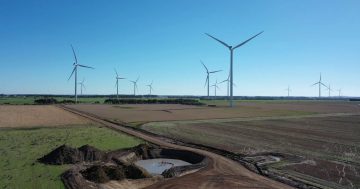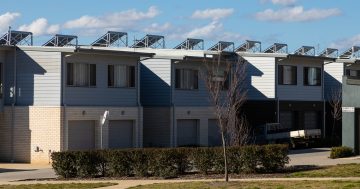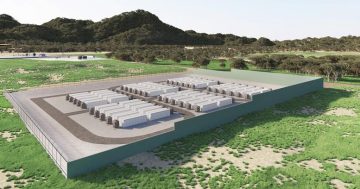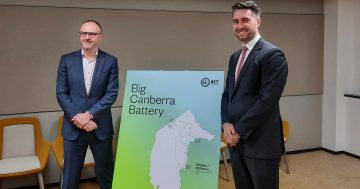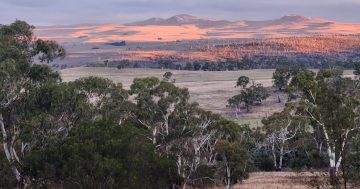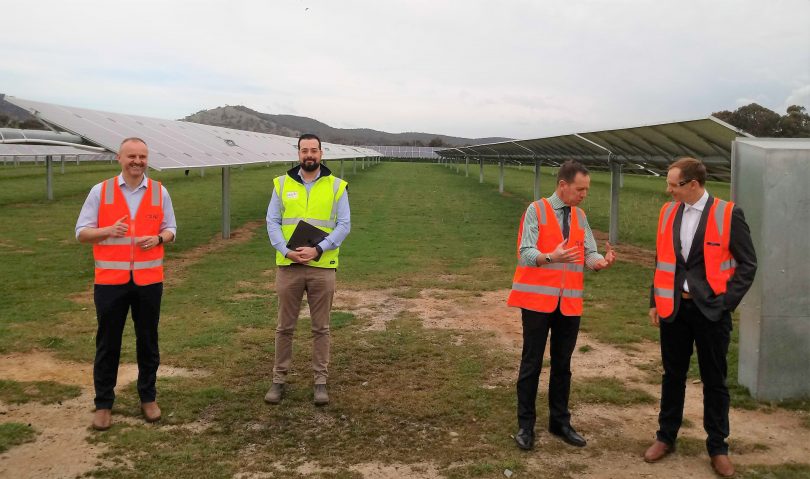
Chief Minister Andrew Barr, GPG engineering manager Guillermo Alonso, Minister for Climate Change Shane Rattenbury and Eonen head of development Garth Herron at the Mugga Lane Solar Farm for the announcement. Photos: Ian Bushnell.
The ACT will have its own big battery power back-up in two to three years as part of the latest renewable energy deals struck with suppliers.
The winners of the ACT’s fifth Renewables Reverse Auction will build the large-scale battery storage systems in the Territory to support the grid and provide power to help avoid blackouts during periods of high demand and when large fossil fuel generators fail in heatwave conditions.
Chief Minister Andrew Barr has flagged further announcements before the end of the election campaign on more battery opportunities.
The ACT Government says the latest round of the renewable electricity ‘reverse auction’ will help Canberra stay 100 per cent renewable into the next decade and deliver the best pricing outcome for residents in the program’s history.
Neoen, for Stage 1 of the Goyder South Wind Farm in South Australia and GPG, for Stage 2 of the Berrybank Wind Farm in Victoria, will provide the ACT with 200 megawatts (MW) of additional renewable electricity capacity into the grid.
The companies are also required to invest in Canberra to allow the ACT to further develop its renewable energy industry.
Neoen will build a 50-megawatt hour battery, enough to power 15,000 homes for an hour, at a site to be determined, while GPG will connect its smaller 10 MWh battery to a substation in Beard.
The batteries will also help stabilise the grid as more rooftop solar comes online.
The government says this auction delivered significantly lower prices than previous ACT auctions, with an average price below $50 per MWh, about a third lower than previous auctions.
Neoen has been granted a 10-year feed-in tariff at $44.97 per MWh, and GPG a 14-year feed-in tariff at $54.48 per MWh.
The government says the total cost of the feed-in tariff from all auctions is expected to remain below $4.90 per household per week.
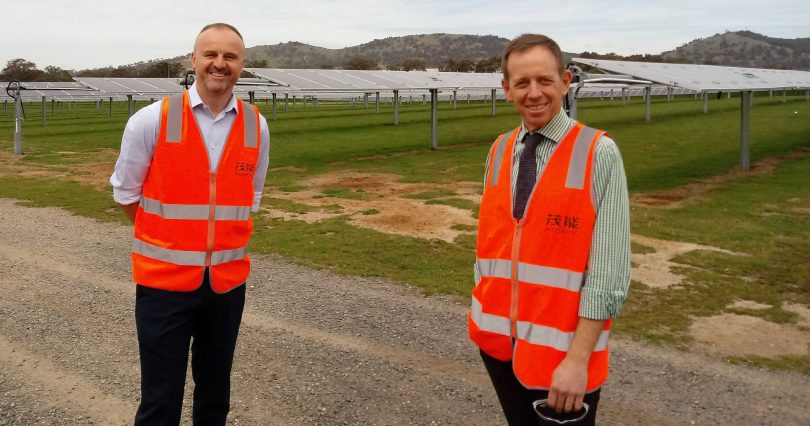
Mr Barr and Mr Rattenbury: the deal is good for the environment and for households.
But Mr Barr said power bills were already falling due to the impact of renewables on the market.
”This is really a very good practical example of clear government policy over an extended period of time delivering the certainty [the market] needs to make large-scale investment and it’s bringing downward pressure on energy prices,” Mr Barr said.
Minister for Climate Change Shane Rattenbury said this was real climate action that was good for the environment and affordable for Canberra families.
He said it would insulate Canberra from the vagaries of the National Electricity Market and enabled the ACT to sell excess power back into the grid when prices were high while ensuring investors had a consistent price.
Mr Rattenbury said Canberra was now recognised as a renewable energy hub that attracted business and research.
He said the two successful companies would commit to staffing in the ACT, training programs with higher education institutions, hydrogen research and contribute to the ACT Renewable Energy Innovation Fund.
Neoen head of development in Australia Garth Herron said a 100 MWh battery took up about a hectare and needed a site near a strong part of the grid such as high-voltage connection points.
The company would be working with Evoenergy to select the right site, and looking to Tesla and other companies to source the battery.
Mr Herron also said the company would be releasing details in coming months of investment opportunities in batteries – essentially an asset-backed investment up to a certain threshold for a fixed return.
Mr Rattenbury said the ACT would probably not have to go to the renewable market again until the late 2020s.












